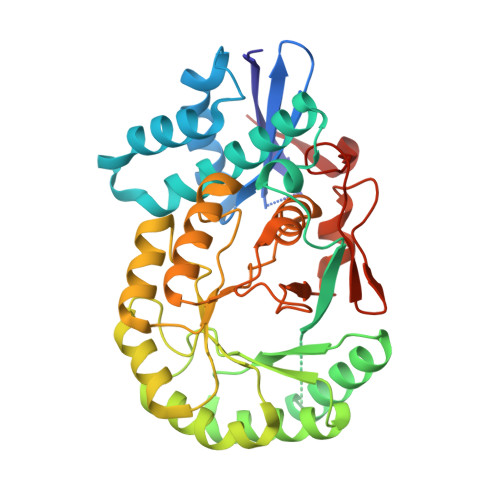Purification, crystallization and structural elucidation of D-galactaro-1,4-lactone cycloisomerase from Agrobacterium tumefaciens involved in pectin degradation.
Vetting, M.W., Bouvier, J.T., Gerlt, J.A., Almo, S.C.(2016) Acta Crystallogr F Struct Biol Commun 72: 36-41
- PubMed: 26750482
- DOI: https://doi.org/10.1107/S2053230X15023286
- Primary Citation of Related Structures:
4GGB, 4HPN - PubMed Abstract:
Pectin is found in the cell wall of plants and is often discarded as waste. A number of research groups are interested in redirecting this biomass waste stream for the production of fuel and bulk chemicals. The primary monomeric subunit of this polysaccharide is D-galacturonate, a six-carbon acid sugar that is degraded in a five-step pathway to central metabolic intermediates by some bacteria, including Agrobacterium tumefaciens. In the third step of the pathway, D-galactaro-1,4-lactone is converted to 2-keto-3-deoxy-L-threo-hexarate by a member of the mandelate racemase subgroup of the enolase superfamily with a novel activity for the superfamily. The 1.6 Å resolution structure of this enzyme was determined, revealing an overall modified (β/α)7β TIM-barrel domain, a hallmark of the superfamily. D-Galactaro-1,4-lactone was manually docked into the active site located at the interface between the N-terminal lid domain and the C-terminal barrel domain. On the basis of the position of the lactone in the active site, Lys166 is predicted to be the active-site base responsible for abstraction of the α proton. His296 on the opposite side of the active site is predicted to be the general acid that donates a proton to the β carbon as the lactone ring opens. The lactone ring appears to be oriented within the active site by stacking interactions with Trp298.
Organizational Affiliation:
Department of Biochemistry, Albert Einstein College of Medicine, Bronx, NY 10461, USA.
















